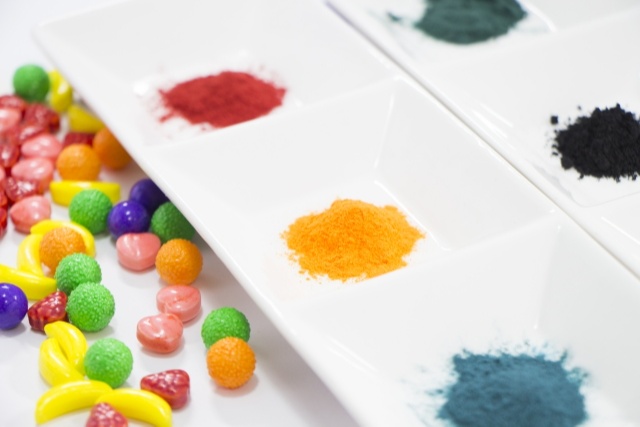Some people may be curious about the ingredients used in edible ink and edible sheets for edible printers. In this section, we’ll introduce the ingredients of edible ink and edible sheets, as well as the printing methods used in commercial food printers.
Ingredients for Edible Ink and Edible Sheets

When printing with an edible printer, edible ink and edible sheets are used. Do you know what ingredients are used to make these edible inks and sheets?
Edible ink
Edible ink, also known as “kashoku ink,” is made from food and food additives approved under the Food Sanitation Law. Edible inks are generally classified into two types: those made with natural colorants and those made with synthetic colorants.
◇Edible ink with natural coloring
Edible inks made with natural colorants use pigments extracted from plants, flowers, and herbs. These inks are known for their soft and gentle colors. Since they are derived from natural sources, they tend to leave a positive impression on customers. Depending on the product, their shelf life is relatively short—typically around 3 months.
◇Edible Ink Made with Synthetic Colorants
Edible ink made with chemically synthesized colorants is known for its vibrant colors. Its safety has been scientifically verified, so it is widely used in various food products. While it depends on the specific product, the shelf life is generally about one year, which is relatively long.
Edible Sheet
Depending on the type of edible printer, some models do not print directly onto the product, but instead print on an edible sheet. These sheets, also known as “edible paper,” are primarily made from starch, similar to oblate. They are tasteless and odorless, so they do not interfere with the flavor or texture of the product, making them suitable for a wide range of items. Edible sheets printed with edible ink can also be freely cut into various sizes and shapes, allowing for greater design flexibility.
Edible sheets can be purchased individually, but buying them in bulk will lower the cost per sheet.
Printing method for commercial food printers

There are three main printing methods used in commercial food printers. The optimal printing method varies depending on the intended use and purpose. If you are considering introducing a commercial food printer, it is important to first understand the characteristics of each printing method.
Thermal type
This method involves heating and transferring dot-shaped ink onto the material for printing. A key feature is its high resolution, making it ideal for printing detailed designs such as photos or intricate illustrations. Additionally, thermal commercial food printers tend to have simple structures, making many of them relatively compact and easy to install. However, the downside is that the ink tends to degrade more quickly due to the heating process.
Piezoelectric
This method uses a piezoelectric element, which changes its volume when voltage is applied, to eject ink droplets. A major advantage of piezoelectric commercial food printers is their high resolution. Additionally, the ink ejection amount can be finely controlled through voltage, making it ideal for printing detailed images such as photos and intricate illustrations. Since piezoelectric printers do not use heat, they have excellent durability and can handle inks containing alcohol. However, piezoelectric printers tend to have a more complex structure, so it is necessary to ensure there is enough space for installation.
Continuous method
This method charges ink droplets and uses deflection electrodes to bend them, spraying the ink onto the printing surface. Continuous inkjet (CIJ) commercial food printers have a lower resolution, so they are primarily used for printing manufacturing dates, expiration dates, and simple logos or text. Like piezoelectric printers, CIJ printers have a relatively complex structure, so adequate space for installation must be ensured.
Contact Mastermind for all your commercial edible printer needs
If you are considering the introduction of a commercial food printer, please consult Mastermind. We offer piezoelectric inkjet and line-head single-pass commercial food printers. The compact "MMP-F13" with piezoelectric technology has been adopted by many patisseries and confectionery shops.
Based on 30 years of accumulated knowledge in special inkjet printers and sales experience, we offer printers that bring greater profit to our customers. If you have any concerns, such as "Can I print on this food?" or "Are there any foods I should be careful about?", please feel free to contact us.



